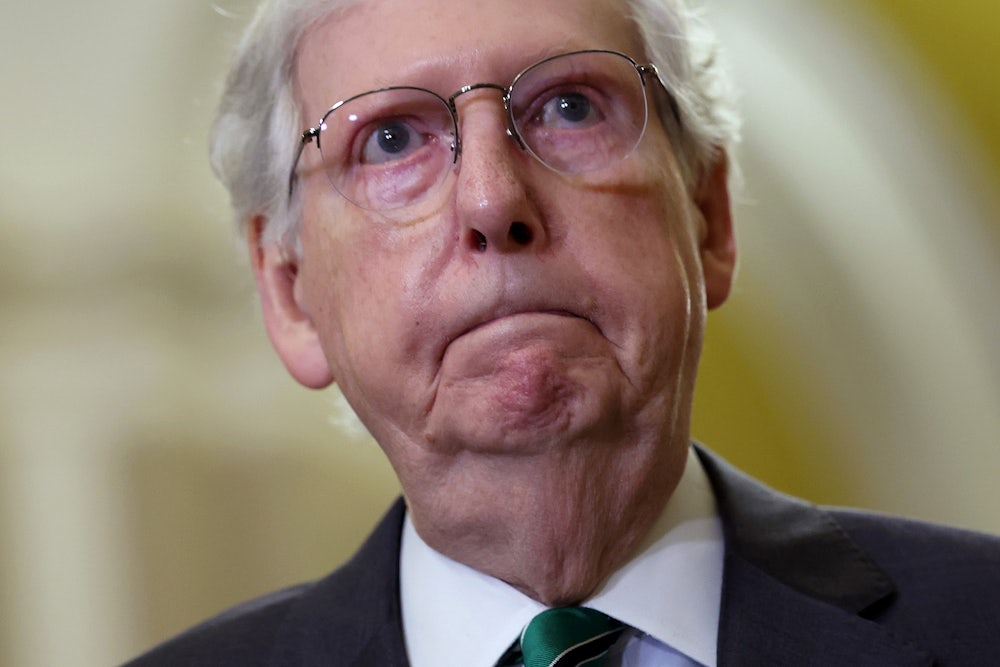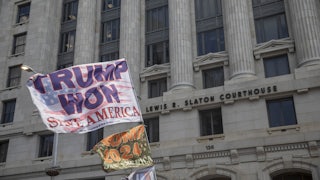Paying the National Labor Relations Board a backward compliment, Republican senators seem to be celebrating Labor Day this year by trying to shut it down. The good news is that they’re making a terrible hash of it.
The NLRB, which tends to get less attention than the Labor Department, is the federal agency responsible for adjudicating disputes between labor unions and businesses. (Despite its name, the Labor Department doesn’t regulate unions all that much.) I wrote early last year that NLRB General Counsel Jennifer Abruzzo was moving fast not only to reverse four years of pro-management decisions under supposed working-class hero Donald Trump but also to expand worker power in other ways. I followed up with reports on Abruzzo’s effort to shut down mandatory-attendance “captive audience” meetings in which managers try to dissuade workers from organizing and her bid to reestablish the informal collection of union authorization cards (“card check”) as sufficient to compel managers to recognize unions.
This last bore fruit last week with the NLRB’s decision in Cemex Construction Materials Pacific, LLC. Granted, the decision by the four-member board, three of them Democrats, did not go as far as Abruzzo proposed, which was to restore the NLRB ruling in Joy Silk Mills. That 1949 decision said management must recognize a union through card check unless it has reason to believe the union doesn’t enjoy majority status. Joy Silk Mills was reversed by a 1969 Supreme Court decision that is itself vulnerable to challenge because it was based on a pretty serious misunderstanding of NLRB policy at that time.
The Cemex Construction decision didn’t resurrect Joy Silk Mills, but it was still a huge victory for labor because it said that if management commits any labor violations during an NLRB-supervised election, then the NLRB can compel management to recognize the union based solely on card check. Since labor violations fall like gentle spring rain on just about every NLRB-supervised election—last year there were more than three unfair labor practice charges filed for every union representation petition—we can expect to see many more union locals winning recognition under the Biden administration, barring intervention by a federal judge. (The Cemex decision will almost certainly be challenged in court.)
I mentioned that Cemex was the product of a four-person board, three of whose members are Democrats. Ordinarily the NLRB has five board members, three from whatever party controls the White House and two from the opposing party. Under President Biden that means three Democrats and two Republicans. But right now the NLRB has only one Republican. Perhaps you suspect that the Biden administration, to maximize its partisan advantage on the board, is dragging its heels in submitting a Republican nomination to the Senate. Presidents of both parties have been known to do that. More often, though, presidents have paired a nominee of their own party with a nominee of the opposition party to make it easier to get both confirmed by the Senate. (NLRB board members serve five-year terms.)
The Biden White House isn’t doing that. Democratic NLRB member Gwynne Wilcox, whose term expired August 27, was cleared in July for renomination by the Senate Committee on Health, Education, Labor and Pensions; a floor vote is scheduled for September 6. Wilcox is not paired with a Republican nominee to fill the empty GOP slot that Republican John Ring vacated last December. Why not? Not, it seems, because Biden is dragging his heels, but rather because Senate Minority Leader Mitch McConnell has not, as is customary, furnished the White House with the names of possible Republican candidates to take Ring’s place. He’s had eight months to do so. I’m told McConnell’s office screened at least one possible candidate, but he doesn’t appear ever to have recommended anybody to the White House.
I say “it seems” and “he doesn’t appear to have” because had McConnell submitted one or more names to the White House, and had Biden then rejected that name or names, then McConnell or his staff would have complained loudly and very publicly. That’s how the game is played. McConnell would have no motive to keep such a snub private, and every reason to accuse Biden of partisan obstruction. So it’s pretty close to certain that McConnell didn’t forward any name or names. I’ve queried McConnell’s office about this and received no reply. Bloomberg asked the White House last week and got no explanation there either.
I asked some of my more savvy pro-labor and pro-management sources what’s going on. They didn’t know.
“My sense is the White House is open to a Republican name,” Wilma Liebman, who chaired the NLRB under President Barack Obama, told me.
“There has not been any announcement made as to who or if the Republicans have put forth a name to be paired with Wilcox,” Michael Lotito of the management-side law firm Littler Mendelson told me. “It’s a very odd situation.”
McConnell opposed Wilcox the first time she was nominated to the NLRB, along with all but one of his fellow Senate Republicans, and he’ll surely oppose her this time. Perhaps he wants to be able to say he’s voting against Wilcox this time because the Biden White House won’t pair her with a Republican. But that would invite Biden to counter that he can hardly pair Wilcox with a Republican if McConnell won’t give him a Republican to nominate. And anyway, Wilcox will likely be confirmed. Republican Senator Lisa Murkowski voted for her last time, and this time Murkowski’s already voted in committee to reconfirm. The Democrats’ Unreliable Labor Caucus of Kyrsten Sinema (now an independent), Joe Manchin, and Jon Tester also voted last time to confirm Wilcox. Conceivably one of them could use Cemex or some other pro-labor NLRB decision as a pretext to withdraw support, but none has raised a peep about that yet.
If Republicans did succeed in blocking Wilcox, so what? There would still be a three-person NLRB with a two-to-one Democratic majority. Republicans might try to argue that a three-person NLRB ought not to overturn precedents—that is, it ought not to continue reversing past pro-management rulings. But at the NLRB, three members constitute a quorum, and three-member NLRBs have overturned precedents in the past. An additional Republican tactic might be to try to get the NLRB down to two members. A two-member NLRB lacks a quorum and can’t issue rulings. But no NLRB seat will be vacated before December 16, 2024, when the term of NLRB Chair Lauren McFerran, a Democrat, expires. That’s a long time to wait. Every possible strategy that Senate Republicans might be following is maladroit to a degree one associates less with the Senate than with the House under Speaker Kevin McCarthy.
Maybe there is no strategy. In the past, McConnell has been highly attentive to NLRB vacancies because these matter a lot to the business lobby. This time he has not. McConnell is 81, and there have been scattered reports lately that he isn’t quite himself. He’s taken three tumbles, one of which gave him a concussion, and in July he froze in midsentence at a press conference. The minority leader is clearly unwell, and his odd behavior around choosing a Republican NLRB member may be a consequence. If that’s what happening, then his staff can no longer cover adequately for him. That would be a sad reason for Republicans to fumble their anti-labor strategy, but the fumble itself is still a fortunate outcome for anyone who cares about labor rights.






